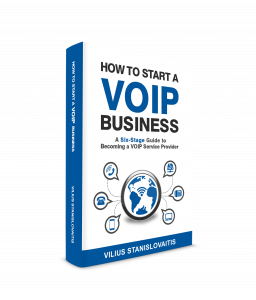First things first, make a plan
There is no progress without proper planning. In the business world, adequate planning is usually the difference between success and failure. A proper plan is ideally split into short-term and long-term goals.
Short-term goals go a long way in establishing a VoIP business, or any business for that matter. We will cover the key short-term goals you need to complete to start a VoIP business:
- Understand the technology
- Choose your business model
- Make your system live—build your infrastructure
- How to find suppliers
- How to find clients.
After the business is set and running, you will be able to focus on the long-term goals, such as:
- Find a way to scale and grow
- Managing risks
- Automate your business.
Advice: Find a trusted advisor
Who doesn’t need an advisor? No matter how much or how little knowledge you possess of VoIP, it is advisable to find an advisor you can trust and properly relate to. A good advisor can help you grow your business; thus, the advisor can play a very important role in helping you set up your VoIP business. A good advisor helps take away the chunky part of setting up a new business.
Finding a good advisor should be prioritized, especially by those with little or no knowledge of VoIP.
UNDERSTANDING THE TECHNOLOGY (VoIP)

VoIP stands for Voice over Internet Protocol. The technology allows users to make voice calls over the Internet.
How it works (technological aspect)
Voice is converted from an analog signal to a digital signal and is then transmitted across the Internet as normal data.
Terminology
In VoIP, the use of abbreviations and acronyms is very common. Here are some of the key “buzzwords” and their meanings to get you started:
- Codec: A codec, which stands for coder–decoder, converts an audio signal (your voice) into a compressed digital form for transmission over the Internet (VoIP) and then back into an uncompressed audio signal for replay. The codec is at the heart of VoIP. Codecs vary in the sound quality, the bandwidth required, the computational requirements, etc. The most common codecs are G711 and G729.
- SIP: Session Initiation Protocol (SIP) is a communications protocol that allows for the transfer and receiving of multimedia messages. It is now the de-facto standard in VoIP.
- DID: Direct Inward Dialing (DID) is a telephone service that allows a phone number to ring through directly to a specific phone at business instead of going to a menu or a queue and needing to dial an extension.
- PSTN: Public Switched Telephone Network (PSTN) is an old system, where copper cables are used to carry voice data.
- QoS: Quality of Service (QoS) refers to any technology that manages data traffic to reduce packet loss, latency, and jitter on the network.
- CDR: A Call Detail Record (CDR) is a data record produced by a telephone exchange or other telecommunications equipment documenting the details of a telephone call or other telecommunications transaction (e.g., text message) passing through that facility or device. The record contains various attributes of the call, such as time, duration, completion status, source number, and destination number.
- CID: Caller Identity is a caller’s number.
- Concurrent calls: The main parameter indicating the capability of softswitches, specifically describing how many simultaneous calls it can handle
- IVR: Interactive Voice Response (IVR) is a technology that allows a computer to interact with humans through the use of voice and dual tone multi-frequency (DTMF) input via a keypad.
- ISP: Internet Service Provider (ISP) simply refers to the organization that provides the user with Internet access.
- PBX: Private Branch Exchange (PBX) is a telephone exchange or switching system that serves a private organization and permits the sharing of central office trunks between internally installed telephones as well as providing intercommunication between those internal telephones within the organization and without the use of external lines.
- Softswitch: A softswitch is a software-based device in a VoIP network utilized for managing voice traffic and routing calls within the network. Class 4 switches route calls between call suppliers, while Class 5 switches connect suppliers with real clients (or end users), who actually make and receive calls.
- LCR: Least-Cost Routing (LCR) refers to a method for choosing the path for calls based on cost.
- MNP: Mobile Number Portability (MNP) refers to the ability for users to retain numbers when switching network providers.
- NOC: Network Operation Center (NOC) refers to the facility that monitors and controls the flow of network data. [In telecommunication environments, NOCs are responsible for monitoring power failures, communication line alarms, and other performance issues that may affect the network, and in the telecom sector, they also have to track details about the call flow.]
A few words about VoIP quality
A number of factors can cause poor VoIP quality, including:
- Jitter: Information is broken down into packets before traveling over the Internet and is then reassembled at the final destination. When such information is reassembled in the wrong order, it is known as “Jitter.”
- Packet loss: Sometimes, packets of data are lost during transport, this results in gaps in audio transmissions.
- Latency: This refers to the audio delay time, from the speaker’s utterance to the listener’s hearing in the VoIP process. Audio messages travel from the speaker to the listener and depending on the quality of the Internet connection, there may be a delay.
- ASR/ACD: The Answer–Seizure Ratio (ASR; representing the percentage of successful calls against the total number of calls attempted) and the Average Call Duration (ACD) are the most commonly used metrics to indicate VoIP route quality.
CHOOSE YOUR BUSINESS MODEL/NICHE

As with all decisions, it is wise to know your strengths as well as your limits before making a firm choice. There are several factors to consider in this category, including:
- Skills level/experience: Experience typically determines the size of the business and the speed of how fast you can grow.
- Finances: The amount of money at your disposal is another factor to be taken into consideration. The amount of money may be a deciding factor for the business size or even its nature.
- Team: If you have a partner(s), what are their strengths?
- Contacts: Maybe you are not new to the industry and you can exploit this opportunity?
What are the necessary questions you need to ask yourself?
In the course of establishing a business, some questions need to be asked and clearly answered to help ensure the business turns out successful, such as:
- What problems am I trying to solve for my clients? This question carries a huge significance when creating a business and will likely provide the key areas of focus as the available resources are channeled toward the identified problems in an attempt to ensure an improved output.
- Do I have a special opportunity? As with most things in life, timing is of the essence. At the right time, there is likely going to an increased demand for some special service in the VoIP field; thus starting a business in this field has a good chance to be profitable.
- How am I different from my competition? In a billion-dollar industry like VoIP, one of the major challenges remains the competition. Making sure your business thrives in this market revolves around the differences between you and the competition.
- Do I have enough finances? Even as you answer the other questions, the question of finance is always a key consideration. Also, the requirements laid out by the answers to the other questions may have to be streamlined in line with your budget to create the perfect VoIP business you can within your budget.
Let’s go over various types of VoIP businesses so you can familiarize yourself with the options.
Call Center Solutions
Call Centers are dedicated to making and receiving calls. VoIP eliminates the need to use one location to house all the agents required for such purposes. VoIP offers call center solutions by increasing efficiency, reducing call-waiting, and offering reduced costs on all calls, giving companies a chance to maintain or even expand their business, all at reduced costs.
Calling Cards
Calling Cards are a good method of establishing limits on spending while making calls. This is a very useful service in VoIP as it affords the client the option of sticking to a budget. Calling Cards can exist either as “pin or pinless.”
- Pin Calling Cards: Pin cards contain codes that give the user access to a specific amount of call time. They can be used once and require no further forms of verification during the recharge process.
- Pinless Calling Cards: In this method, pin codes are generated by the user. This method involves further verification and thus may be considered as more secure. The verification process is done through caller ID, callback services, or mobile phone apps and may include other new services.
Call Shops
Call Shops are locations where individuals can go to make web calls, for which they are charged upon finishing. Call Shops tend to provide less expensive services and offer call services over long distances, hence reducing the costs for clients.
IP/PBX (Public Branch Exchange)
An IP PBX serves as the gateway between VoIP and the rest of the world. The PBX can exist either as hardware or as software (an application). A PBX allows users the option to either call other VoIP lines or to call regular phone lines, and vice versa, over the VoIP network.
Unified Communications
This refers to a group of applications that aid different forms of communication. It does not refer to just a single application, but rather, various platforms that support different communication methods, such as instant messaging, video conferencing, screen sharing, email, voicemail, and SMS.
VoIP Wholesale Provider
A VoIP Wholesale Provider refers to a company that supplies VoIP services to other VoIP network providers. The wholesale provider is not limited to other VoIP providers only and can provide services to residents, businesses, and institutions
SIP Trunking
SIP Trunking allows connecting old PBXs to VoIP (usually over SIP or H323 protocols). This enables offering calls at low cost, without the need to replace old equipment or telephone systems.
Mobile VoIP
Mobile VoIP provides the user with a cost-efficient method to use their mobile phones in conjunction with VoIP. It uses mobile networks or even the Wifi service of the mobile phone to provide top-notch connections to communicate by VoIP.
Services include voice and video calls, SMS, and even sharing multimedia messages, all while eliminating regular call costs. The most well-known examples include Skype, Viber, WhatsApp, and Messenger.
Residential VoIP
Residential VoIP refers to using VoIP in the home and offers a cost-saving alternative for all communication services by providing an outstanding communication platform with low cost, giving homeowners one less thing to worry about in the household.
Be an expert in your own product and your specific niche
One way to stay ahead of the curve is to ensure that you possess all the relevant expertise and technical know-how to overcome any and all problems that might arise. Different niches require different methods of control.
There are two options for VoIP businesses: VoIP reseller or provider
Reseller vs. Provider
A VoIP reseller simply brings VoIP services to users. The reseller does not own the servers or generate bandwidth, whereas the provider is the main source of the network. The reseller typically bears little risk, and simply makes a profit from reselling VoIP products and services, while the provider bears the main risks, such as equipment malfunction, failure, or damage. On the other hand, the provider usually makes more money, but the reseller has fewer worries and does not need much upfront investment.
Competition
As with every lucrative business, competition can be fierce and VoIP is no exception, and the industry is very highly competitive. A good businessman though knows he can best his competitors by simply making his product more enticing than his competitors. Some common ways of doing this include:
- Cheaper prices
- More features
- Easy to use
- Better payment terms
- A long history of trust with partners
- Strict quality control.
INFRASTRUCTURE

As earlier stated, a reseller does not need to invest in hardware. However, a provider will need to invest in certain equipment to be able to provide VoIP services. Once you have decided to be a provider, you will be faced with two options: to either rent or buy equipment.
Hosting Provider
When you resell VoIP, or provide VoIP services, one key factor to the success of your business is having a top-notch hosting provider. The hosting provider hosts the VoIP servers, meaning all VoIP connection pass through the provider. A fantastic hosting provider without service availability issues or customer complaints is bound to support a business to become successful.
Softswitch
Softswitch: A softswitch is a software-based device in a VoIP network utilized for managing voice traffic and routing calls within the network. Class 4 switches route calls between call suppliers, while Class 5 switches connect suppliers with real clients (or end users), who actually make and receive calls.
Functions
As stated earlier, the softswitch is the brain of the VoIP system, carrying out a series of functions that are essential to the smooth running of the VoIP. This means that choosing a high-quality softswitch goes a long way toward determining the success of your business. Some of these functions include:
- Billing: Softswitches use Call Detail Record (CDR). This provides records during calls, which are then used for billing. Some softswitch devices do not have this feature integrated and as such billing options must be bought separately.
- Routing: A typical softswitch contains a basic Least Cost Routing (LCR) feature. This feature ensures that all VoIP operations use the most appropriate plan available for such an operation. There are several different types of routing, such as:
- Routing by Priority (forced/preference routing)
- Routing by Preset Proportion (percentage-based routing)
- Routing by Quality (adaptive routing based on ASR/ACD formula)
- Routing by CallerID (origination-based routing)
- Routing according to a time period
- and others (which you likely will not need at first).
- Rate Management: It is important to make sure that softswitch has adequate rate management functionality. Dealing with Rate Lists (Tariffs) from different suppliers can be troublesome and takes a lot of time because the majority of them will be in different formats.
- Stability/Redundancy: Interruptions in VoIP usually mean a loss of income. Redundancy simply refers to the fortifying of your hardware and software against potential failures, including by having more than one server and even the use of cloud storage, as long as they are reliable. You could consider Dual Location Redundancy to protect your hardware from attacks and natural disasters. This is usually neglected by novice players until they suffer inevitable service disruption due to failed hardware, software, network, or human problems, and then realize its importance.
Some other functions include:
- Live call monitoring
- Analysis and reporting
- DID management
- Payment management.
NOTE: You should ensure the softswitch you use supports all the protocols and codecs you need as it may not be compatible, and then your service won’t proceed. Hint: At least make sure it supports the SIP protocol and G711/G729 codecs. This will cover you in 95% of cases.
Maintenance
Routine inspection, monitoring, and even frequent updates are required to keep your VoIP service functioning as optimally as possible. Make a plan who will do these tasks, when, and how often to avoid future problems.
Backups
As long as all data is backed up, customer satisfaction is guaranteed, since all issues can be traced and rectified. An added value, if there is ever a need to start again, is that having all backed-up data can help speed up the start-up process if needed.
Security
There are a few risks to your system that need to be watched out for:
- DDOS attacks: A DDOS attack is a type of cyber-attack in which the perpetrator seeks to make a machine or network resource unavailable to its intended users by temporarily or indefinitely disrupting the services of a host connected to the Internet.
- Hacking: Hacking is unlawful accessing of servers by various means.
- Fraud: The main risk of fraud is not getting paid by a client. This can happen, for instance, when a postpaid service is used.
- Solution: Only use such services with trustworthy customers who have a good reputation and who are well-established among VoIP community members. When starting a business with a supplier, learn about antifraud forums such as www.voipfraud.net/en and sites providing tips on how to avoid being a fraud victim. For example, avoid companies that have had issues or reviews/comments made relating to fraud. Always carry out a thorough research on every potential partner.
Choosing the right softswitch
Choosing your softswitch device is a very important decision and as such should not be taken lightly. The more efficient your softswitch device, the more income is likely to be generated. Here are some things to consider when choosing:
- Price (initial/outgoing)
- Functionality
- Product/company reputation, their time in the market, etc.
- Ease of use
- Support options
- Integration options
- Customization options
- What your partners/clients/suppliers use.
Customer management/support
Every successful business boasts outstanding customer service. Not just during a purchase, but also throughout warranty services as well as during routine maintenance and even for upgrades to old products.
This requires maintaining a relationship with potential and existing customers through constant and routine communication. This could be achieved by offering free tips on how to do certain things without the help of experts or a platform for customers to air their views. All these help improve customer brand loyalty. This process entails some of the following methods:
- Trouble Ticket System (Help Desk)
- Live-chat
- Phone calls
- Emails
One way of ensuring you stay ahead of the curve is to ensure you don’t wait for a customer to call and make complaints. Instead, make routine follow-up calls and control the situation.
FINDING SUPPLIERS

By now you’re getting ready to go live, and a significant effort has already gone into launching your business. However, a few steps remain to get you up and running, including finding suppliers. With the right supplier, it’s easy to have a successful business, but with a bad supplier, you are likely to encounter technical problems, such as dropped connections, bad routes, 503 errors, and capacity issues. Therefore, choosing the right supplier is of great significance when setting up your business.
Where and how to find suppliers
Websites, forums, and chat rooms are great places to find people or organizations as potential suppliers. Every company seems to have a website nowadays as well as social media accounts detailing all the necessary information to help you make an informed decision when choosing your supplier. Some of the relevant questions you may want to ask as part of your research are:
- How long have they been in business?
- Can they provide Trade References?
- What is their supported capacity?
- What are their billing increments (1/1, 6/6, etc.)?
- How many providers do they keep in their routing groups?
- How many providers have to fail before they send a 503?
- How many customers do they support? (Note: If the company does not support many customers, this could be an indication of poor service or that it is not well established.)
Some examples of websites and forums where you can find suppliers include:
Here are also some pay-as-you-go online suppliers to get you started:
Once all these questions have been answered, you should also check their feedback and comments from existing customers to check the quality of service that you can expect from the prospective supplier. Once this part is done and your mind is made up, you need to ensure that no purchase is made without first thoroughly reading the contract before signing it. Ensure that every aspect of the agreement is documented and even have a legal practitioner review it before signing. Only then can your business together commence.
FINDING CLIENTS

After getting your supplier, the next goal is to find clients. You might start with one client and ensure that you can meet all that client’s VoIP needs, and then once that is done, you might find one more and then the next one until your entire network is established.
NOTE: Do not rush into supplying too many clients too soon as the process may become overwhelming and result in unforeseen errors. It is best to grow the business gradually.
You can perfect your business by following the steps listed below.
- Understand your client’s needs: Once you understand your client’s needs, it provides you with an opportunity to cater specifically to those needs and helps improve your relationship with your client.
- Get feedback: Don’t wait for your client to call you with a problem, contact them to get their opinion of your product and suggestions from them as to how you can improve the quality of your service.
- Improve on the feedback: Once you have gotten feedback from your client, the next step is to implement changes based on the client’s suggestion to ensure that the client is absolutely satisfied with your service.
- Prepare a blueprint: Once the service is perfected to the client’s taste, use the product to prepare a blueprint for an improved product, one that exceeds even your client’s expectations.
- Test it on more clients: Once you have your blueprint, move to test it on more clients.
- Improve: Get feedback from your new customer base so you can improve your product to satisfy a larger customer base.
- Repeat: Repeat the process until you have a product that is ready and able to satisfy the general public.
Where and how to find clients
VoIP forums and chat rooms are crawling with potential clients. Contact some of them and make them aware of your product through offering free trials and by showcasing available features/routes. You can also generate awareness about your service through traditional advertising channels.
Marketing and sales
This ranges from educating potential clients about your service to demonstrating and finally selling your service. Here are some tips as well as questions you need to ask yourself to help you in this step.
- What will set you apart? With the number of people in the VoIP market, you need to have something that sets you apart from the competition and that this will attract new clients to your product. Perhaps, your service is faster than others, cheaper, better, or even smarter. All these can give you an edge over the competition.
- Pricing: You don’t need to devalue your product in an attempt to make your product cheaper than the competition, instead you can make your product cheaper by:
- Adding extra features without a price increase
- Including extra equipment with sales
- Offering free transitions between products and services
- Offering sales deals based on the customer’s needs
- Attaching benefits to added features.
- Educating your client: Know your client’s business and how your product can help improve their business. By doing this, you gain a loyal customer, as well as establishing yourself as an expert in your field.
- Case studies: Make references to case studies and learn from them in order to improve the quality of your product.
- Testimonials: Share the experience of your satisfied customers to establish the impact of your product.
- Demonstration: Carry out public demonstrations of your product, showing its special features as well as its advantage over other products.
- Prepare to address any objections and fears: Be ready to answer all questions from your audience, especially questions trying to highlight negatives.
- White labeling: This refers to a system where a company supplies products under its own name, but actually sources the products from other reliable companies. It provides the following advantages
- Time and production costs are saved
- Eliminates the stress of setup
- It helps build the business firmly.
Finding clients is best perfected with a few individuals until you are sure the product is ready for the larger market.
As you progress, please remember the following:
- Become an expert in your field, helping set you apart from your competitors and attracting new clients to your business.
- Change can be scary to prospective clients, so you need to reassure them why your product is a welcome change. You can achieve this by sharing testimonials, laying out a clear transition plan, and by making references to case studies.
- Don’t just sell a commodity, sell added value, e.g., Unified Communications as a Service (UCaaS).
- The added value should make life easier for your clients.
CONCLUSION

We hope that this short guide gives you a better understanding of the VoIP business, including what it is all about, and what knowledge you need to possess or gain to start and prosper in it.
And never forget that there are always people and companies willing to help you on your journey. Learn how to ask the right questions and never stop moving forward.
To learn more about VoIP business please check this book:

How to Start a VoIP Business: A Six-Stage Guide to Becoming a VoIP Service Provider is the first book which explains in plain English how to become a VoIP provider and start different services, based on a VoIP technology. This simple six-stage guide will give you the know-how of launching services, such as Mobile VoIP, Callback, Calling Cards, Call Shops, Residential VoIP, Virtual PBX, SIP Trunking, Wholesale Transit, Call Origination, and Call Termination. You can buy the full book here.
Download FREE book sample here.
Best of luck in your adventures!

Very helpful to start a VoIP reseller business. VoIP business is still profitable or not and what is the minimum investment need to start VoIP reseller business?
If you start VoIP business as Reseller of VoIP provider, no investment is needed as you use infrastructure of your VoIP provider and work on commission basis. I see you are a VoIP provider yourself, can you share your numbers? How much do you charge if someone wants to resell your services?
Hi Mindaugas. Thanks for sharing such a brief blog on VoIP Business SetUp. I was planning to set up a startup and was new to VoIP technology. After reading your blog, I got to know what all steps I have to consider while setting up the business. However, can you suggest any appropriate VPN routers that would be stable enough for a VOIP system? Also, what sort of specification should I be looking for to decide on what hardware we require?
Thank you, Alexia, for your comment. I can’t answer about the VPN, because it is out of scope of our experience. Our clients just report us some problems with various VPN’s but it is up to their network engineers to implement working solutions
Here you can find recommendations about the hardware: http://wiki.kolmisoft.com/index.php/Recommended_hardware